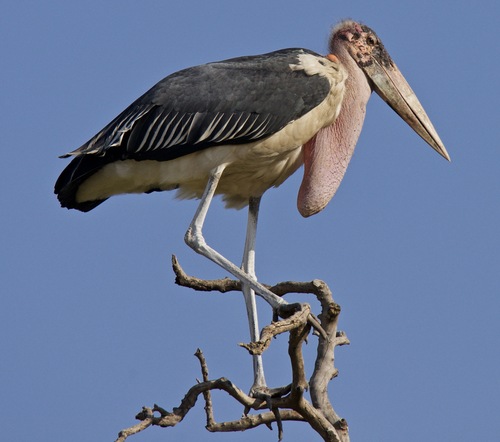
Marabou Stork
The Marabou Stork (*Leptoptilos crumenifer*) is a large wading bird, instantly recognizable by its imposing size, bare head and neck, and distinctive gular sac. Often referred to as the "Undertaker Bird" due to its cloak-like wings and hunched posture, it plays a crucial role as a scavenger in its African ecosystem. While not considered beautiful by conventional standards, the Marabou Stork is a vital component of its environment, helping to control disease by consuming carrion and waste. It holds little specific cultural significance beyond its prominent role in the ecosystem, though it is sometimes featured in local folklore.
120-152 cm
Length
225-287 cm
Wingspan
Least Concern
Conservation Status
Distribution
Sub-Saharan Africa, extending from Senegal and Mauritania in the west to Ethiopia and Somalia in the east, and south to South Africa. It is generally non-migratory, though some populations may undertake local movements in response to food availability and rainfall.
Lifespan
Up to 25 years in the wild, and potentially longer in captivity.
Marabou Stork's Habitat
Habitat Types
Savannas, Grasslands, Wetlands, Swamps, Lake edges, Riverbanks, Human settlements (near landfills and slaughterhouses)
Climate Zones
Tropical, Subtropical
Adaptations
Their bare head and neck are adaptations to their scavenging lifestyle, preventing feathers from becoming soiled with blood and other fluids. The large gular sac is used in courtship displays and possibly in thermoregulation. Their long legs allow them to wade in shallow water.
Variations
No widely recognized subspecies exist, although there may be slight regional variations in size and plumage.
Appearance
Breeding Plumage
There is little difference between breeding and non-breeding plumage. Adults have mostly white underparts and black upperparts.
Seasonal Feather Changes
No significant seasonal variations.
Sex Based Plumage Differences
Minimal sexual dimorphism in plumage; males and females appear similar.
Notable Features
Bare, pinkish head and neck, Large, inflatable gular sac at the base of the neck, Massive, wedge-shaped bill, Dark, slate-grey legs
Diet and Feeding
Primary Foods
Carrion, Fish, Frogs, Insects, Small mammals, Reptiles, Bird eggs and chicks, Human refuse
Foraging Behavior
Primarily a scavenger, feeding on carcasses alongside vultures and other scavengers. It also actively hunts small prey, wading in shallow water or stalking through grasslands. They often frequent landfills and slaughterhouses.
Specializations
The strong, sharp bill is adapted for tearing flesh from carcasses. Their long legs and neck allow them to reach food in various environments.
Seasonal Diet Variations
Diet may vary depending on the availability of food sources. During the dry season, they may rely more heavily on carrion, while during the wet season, they may hunt more live prey.
Behavior
Social Structure
Often found in large flocks, especially near food sources. They are colonial breeders, nesting in trees or on cliffs, often alongside other stork species.
Communication
Gular sac inflation during displays, Bill-clattering, Grunts and croaks
Migration
Generally non-migratory, but local movements may occur in response to food and water availability.
Territorial or Group Behaviors
Breeding colonies are defended against intruders. Outside of the breeding season, they are generally gregarious and tolerant of other individuals.
Conservation
Threats
Habitat loss (due to agriculture and urbanization), Poisoning (from consuming poisoned carcasses intended for predators), Collision with power lines, Human disturbance at breeding sites
Protection Programs
General protection under national wildlife laws in many African countries., Some protected areas encompass Marabou Stork habitat.
Local National Laws
Varies by country, but generally protected under wildlife legislation.
Population Trend
Stable
Population Estimates
The global population is estimated to be between 100,000 and 300,000 individuals.
Interesting Facts
They can soar to great heights on thermals.
Despite their size, they are efficient fliers and can use rising air currents to gain altitude.
The gular sac is not used for storing food.
It is primarily used for display during courtship and possibly for thermoregulation.
They are often seen alongside vultures at carcasses.
Their strong bills allow them to access parts of the carcass that vultures may not be able to reach.
They are known to stand still for long periods.
They will stand and wait for prey, or a good opportunity to scavange.
Marabou down was formerly used to trim hats and clothes.
The soft, white feathers on their underparts were a popular fashion accessory.
Faqs about Marabou Stork
Why do Marabou Storks have bare heads?
This is an adaptation to their scavenging lifestyle. It prevents feathers from becoming soiled with blood and other fluids when feeding on carcasses.
What is the purpose of the gular sac?
The gular sac is used in courtship displays and may also play a role in thermoregulation.
Are Marabou Storks dangerous?
They are not typically aggressive towards humans, but they are large and powerful birds and should be treated with respect. They can inflict a painful bite if threatened.
Do they only eat carrion?
While carrion is the largest part of their diet, they will also eat live prey.
Where do they sleep?
They will sleep in trees, usually in large groups.
Copyright @ Nature Style Limited. All Rights Reserved.
 English
English